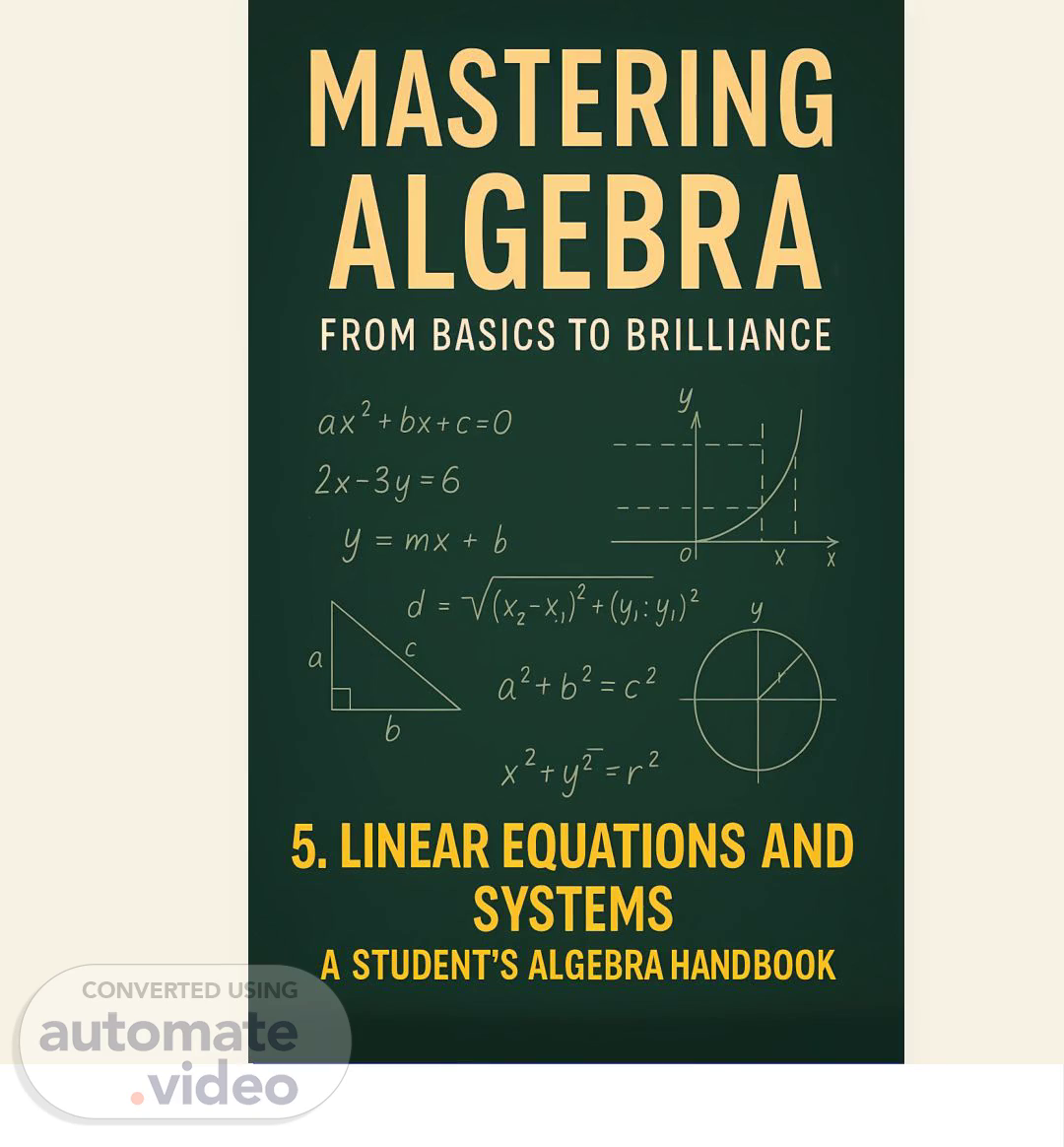
5. Linear Equations and Systems A Student's Algebra Handbook
Scene 1 (0s)
y = mx + b ax + by = c y - y₁ = m(x - x₁) 2x + 3y = 12 y = 2x - 5 x = -3 y = 4 5. Linear Equations and 5. Linear Equations and Systems Systems A Student's Algebra Handbook High School Mathematics Series.
Scene 2 (11s)
Index Linear Equations and Systems Getting Started Introduction 3 Prerequisite Skills 4 Linear Equations Definition and Examples 5 Different Forms of Linear Equations 6 Graphing Linear Equations 7 Solving Linear Equations 8 Systems of Linear Equations Introduction to Systems 9 Solving by Graphing 10 Solving by Substitution 11 Solving by Elimination 12 Applications & Practice Real-Life Applications 13 Practice Exercises 14 Answer Key 17.
Scene 3 (26s)
Introduction Welcome to the World of Linear Equations Why Linear Equations? Linear equations form the foundation of algebra and are essential tools for understanding relationships between quantities. They describe straight lines and constant rates of change, making them powerful models for countless real- world situations. "The study of linear equations opens doors to understanding more complex mathematical concepts and solving practical problems." Real-World Applications From calculating costs and profits to predicting trends and analyzing data, linear equations are everywhere! They help us: Model growth patterns Calculate finances Analyze experiments Navigate routes About This Handbook This handbook is designed to make algebra accessible and engaging for high school students. We've simplified complex concepts and included: Visual examples Step-by-step solutions Practice exercises Real-world problems 3.
Scene 4 (56s)
Prerequisite Skills Building the Foundation for Linear Equations Distributive Property The distributive property allows us to multiply a term by each term inside parentheses. It's essential when changing between different forms of linear equations. Example 3(x + 4) = 3·x + 3·4 = 3x + 12 2(5x - 3) = 2·5x - 2·3 = 10x - 6 Solving for a Variable Isolating a variable is crucial when converting equations to slope- intercept form (y = mx + b). This skill helps us identify the slope and y-intercept. Example Convert 4x + 2y = 8 to slope-intercept form: 2y = -4x + 8 y = -2x + 4 Graphing Basics Understanding the coordinate plane and plotting points is fundamental to visualizing linear equations. Remember that the x- coordinate comes first, followed by the y-coordinate. Example To plot the point (3, 2) : 1. Start at the origin (0, 0) 2. Move 3 units to the right (positive x-direction) 3. Move 2 units up (positive y-direction) 4.
Scene 5 (1m 30s)
Linear Equations Definition and Examples What is a Linear Equation? A linear equation is an equation that describes a straight line when graphed. The key characteristic is that the slope remains constant throughout the line. In a linear equation, variables are raised only to the first power and never multiplied together. Constant slope Variables to power 1 Forms a straight line Examples of Linear Equations Slope-Intercept Form y = mx + b y = 2x + 3 Point-Slope Form y - y₁ = m(x - x₁) y - 5 = 3(x - 2) Standard Form ax + by = c 4x + 2y = 8 Visualizing Linear Equations When graphed, linear equations always form straight lines. The slope determines how steep the line is, and the y- intercept tells us where the line crosses the y-axis. 5.
Scene 6 (1m 59s)
Forms of Linear Equations Three Ways to Express the Same Line Slope-Intercept Form y = mx + b The most common form for graphing lines, where you can immediately identify the slope and y-intercept. m slope b y-intercept Converting to Slope-Intercept 1 Start with: 2x + 3y = 6 2 Isolate y: 3y = -2x + 6 3 Divide by 3: y = -2/3x + 2 Point-Slope Form y - y₁ = m(x - x₁) Perfect for when you know the slope and one point on the line, making it easy to write the equation directly. m slope (x₁, y₁) a point on the line Converting to Point-Slope 1 Start with: y = 2x + 3 2 Identify slope: m = 2 3 Pick a point: (0, 3) 4 Write: y - 3 = 2(x - 0) Standard Form ax + by = c Useful for finding x- and y-intercepts and for solving systems of equations, especially with the elimination method. a, b, c constants (a, b ≠ 0) Converting to Standard Form 1 Start with: y = 2x + 3 2 Move x term: -2x + y = 3 3 Multiply by -1: 2x - y = -3 6.